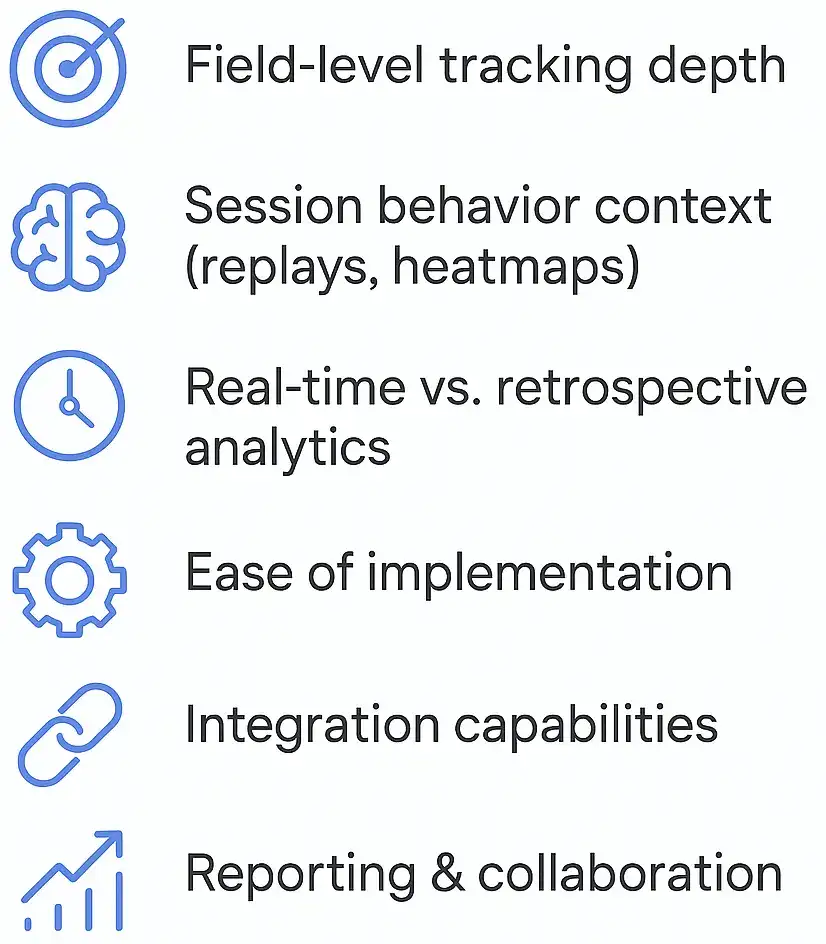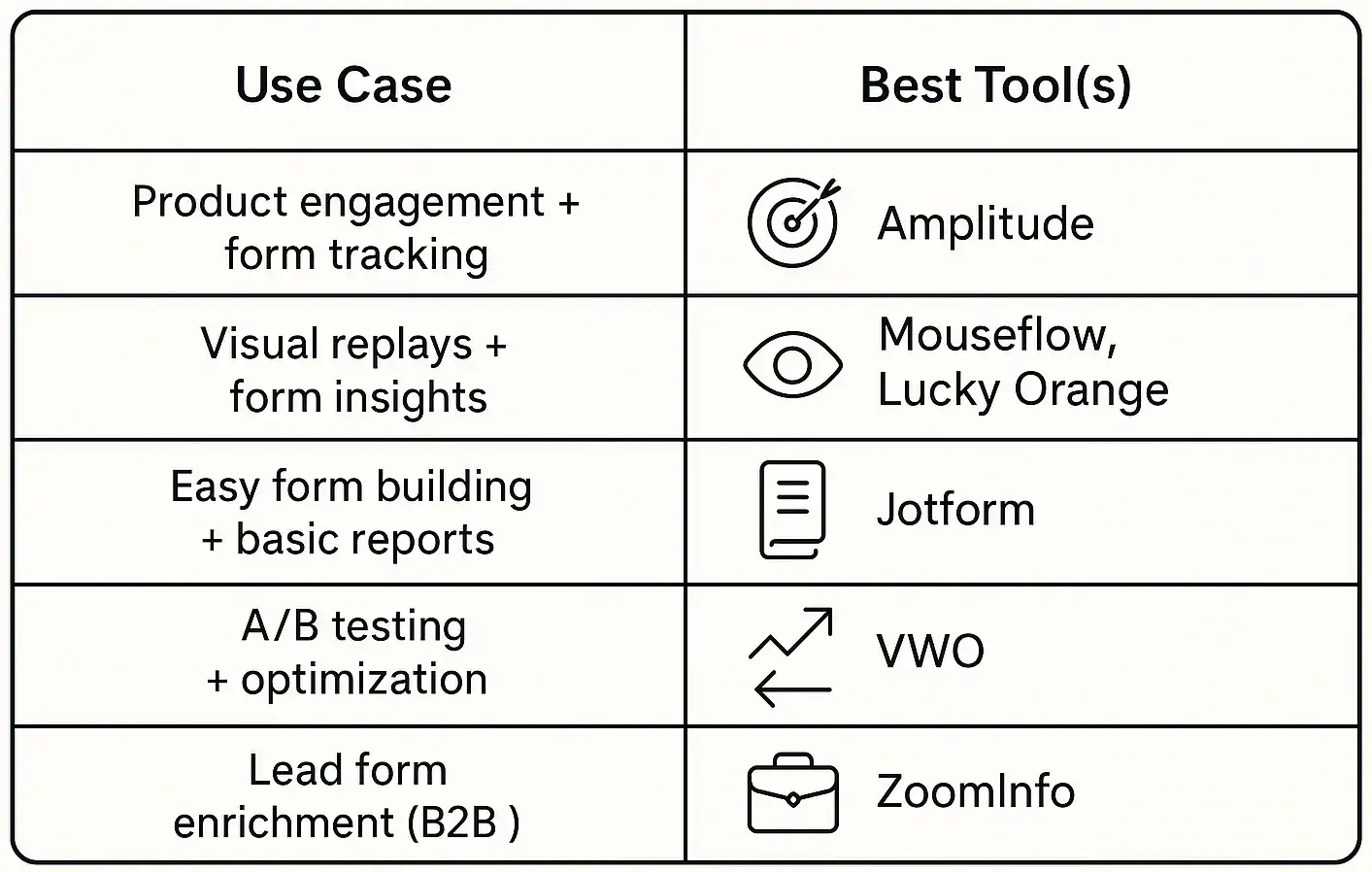We test and review software products using an independent, multipoint methodology. If you purchase something through our links, we may earn a commission. Read about our editorial process.
Forms are where digital experiences meet outcomes. Whether you're collecting leads, onboarding users, or processing payments, forms are where visitors become potential customers—or drop off. Yet despite their critical role, most businesses overlook the power of form analytics tools to identify hidden friction, improve usability, and increase conversions.
Form analytics platforms go beyond traditional web analytics. They track how users interact with individual fields—where they pause, get confused, or abandon. In 2026, these tools are more sophisticated than ever, offering AI-driven optimization suggestions, real-time feedback, and integrations with your broader marketing stack.
This guide covers the top form analytics solutions available today and helps you choose the right one to unlock insights, reduce abandonment, and turn your forms into high-performing conversion assets.
Even small issues in your form—like a poorly labeled field or unexpected error message—can lead to massive drop-offs. General analytics platforms like Google Analytics can show that a visitor exited a page, but they don’t explain why. That’s where form analytics comes in.
These tools offer field-level visibility into:
Abandonment rates
Average time spent per field
Repeated corrections or field re-entries
Validation errors
Drop-off trends by device or source
Conversion rates for individual form versions
By diagnosing exactly where and why users leave, businesses can streamline the form experience, improve conversion rates, and boost revenue—all without increasing traffic.
To assess the best form analytics tools of 2026, we applied our six-factor internal evaluation framework:

Field-level tracking depth – Can the tool identify friction on individual form fields (e.g., address, phone, or password)?
Session behavior context – Does it integrate with heatmaps, session replays, or scroll tracking to give full behavioral insight?
Real-time vs. retrospective analytics – Are insights available live, or only after the fact?
Ease of implementation – Is the setup simple for marketers or developers?
Integration capabilities – Does it connect with CRMs, analytics platforms, or A/B testing tools?
Reporting & collaboration – How easily can teams access reports, share insights, and apply fixes?
Amplitude is a powerhouse in product and user behavior analytics—and it brings that strength to form analytics too. Its event-based architecture allows you to track form starts, completions, and drop-offs, while connecting those behaviors to broader user journeys and retention trends.
Amplitude doesn’t just tell you where users leave—it helps you see how those users behave across the rest of the product or website. You can segment by user type, traffic source, or cohort to understand deeper behavioral trends.
Best for: SaaS companies and product teams looking to connect form data with larger user engagement metrics.
Mouseflow specializes in behavior analytics and includes a robust form analytics module. It tracks every field interaction, error, hesitation, and abandonment, and ties those behaviors to full session replays so you can see exactly what the user did.
With Mouseflow, you get a clear view into which fields cause confusion or drop-offs and how those issues vary across devices or regions. This tool can easily integrate with popular platforms like WordPress, allowing you to analyze scroll behavior and click heatmaps alongside form performance.
Best for: UX and CRO teams who need both data and visual context to improve forms.
Jotform is primarily known as a form builder—but in 2026, it has evolved to include form analytics tools that help users measure submission rates, field performance, and completion times. You can track form submissions, views vs. submissions, conversion rates, and identify which forms or form versions perform best.
While it doesn’t offer advanced behavior analytics like heatmaps, Jotform is ideal for businesses that want easy-to-use forms with basic analytics baked in. It also supports conditional logic and responsive design for better user experience.
Best for: SMBs and non-technical users who need fast form deployment with performance tracking.
VWO is a leader in testing and optimization, and its form analytics module complements that perfectly. The platform tracks user interaction with every field—how long they spend, where they hesitate, and where they drop off—then turns that data into clean visual reports.
VWO also allows you to A/B test form variations to improve performance, making it ideal for teams already focused on experimentation. With form abandonment tracking and field-level insights, it's a go-to for optimizing complex or multi-step forms.
Best for: Marketing and CRO teams using experimentation to boost form conversion rates.
Lucky Orange is a comprehensive behavior analytics platform with form analytics baked in. It tracks engagement at the field level and ties it to session recordings, allowing you to see not just what happened, but how it happened.
With Lucky Orange, you can compare form performance across time, devices, or traffic sources. Its interface is beginner-friendly and includes live chat and polls, making it a great all-in-one solution for businesses focused on improving website usability and engagement.
Best for: Small to mid-sized businesses looking for a single tool to track form performance and visitor behavior.
ZoomInfo's form optimization feature focuses on shortening and simplifying lead capture without sacrificing data quality. Through its Enrichment technology, ZoomInfo enables progressive profiling and hidden fields, allowing users to fill out shorter forms while still collecting complete profiles on the backend.
While not a traditional form analytics platform with heatmaps or replays, ZoomInfo’s strength is in improving form output—specifically for lead generation and B2B sales workflows. It helps reduce form friction by removing unnecessary fields and populating missing data automatically.
Best for: B2B marketing and sales teams focused on improving form conversion and data enrichment.
Forms are often the final hurdle between interest and conversion. Yet many teams leave them unoptimized, missing key opportunities to gain valuable insights, reduce friction, and increase completions. Whether you’re capturing leads, onboarding users, or collecting feedback, form analytics tools give you the clarity needed to optimize performance at the most granular level.

To recap:
Amplitude provides enterprise-grade insight by tying form interactions to broader product engagement.
Mouseflow is excellent for visualizing friction through replays and heatmaps.
Jotform delivers easy form building with built-in performance reports.
VWO is ideal for teams running tests and optimizing forms through iteration.
Lucky Orange offers user-friendly behavior and form insights in one dashboard.
ZoomInfo focuses on lead form performance with enrichment and data optimization.
Whichever platform you choose, one thing is clear: optimizing your forms isn’t a luxury—it’s a competitive advantage.
In addition to using specialized services to analyze Forms 2024, there are other alternatives that can be effective in certain situations. For example, you can use data analysis software such as Microsoft Excel or Google Sheets, which have a wide range of tools for processing and analyzing data.
You can also use programming in languages such as Python or R to create your own scripts and programs to analyze Forms 2024. Some organizations also use statistical packages, such as SPSS or SAS, to perform complex analytical operations.
Alternatively, you can use the services of data analytics consultants or researchers to assist in analyzing Forms 2024, especially in cases where specialized experience or expertise is required.
When choosing a service for analyzing Forms 2024, it is important to consider several key features. First, be sure to pay attention to the data import and processing capabilities, including support for various file formats and options for cleaning and preparing data for analysis.
The second important aspect is the analytical capabilities, such as statistical methods, machine learning, and data visualization, which allow you to get insights and draw conclusions from the results. In addition, pay attention to collaboration and data sharing capabilities, which can be important for collaborative projects or teamwork.
It is also important to consider the possibilities of automating processes and working with large amounts of data, especially if you are working with large datasets of Form 2024. Finally, ensuring data security and confidentiality is a key consideration, so consider whether data protection measures are in place and whether the service meets security standards and regulatory requirements.
There are several ways to optimize the cost of using a service for analyzing Forms 2024. First, consider using free or open-source tools that may have limited but sufficient functionality for your task. Next, consider using a subscription to a service only for periods when you really need its functionality.
You should also carefully evaluate your resource needs, such as memory and processing power, and choose a plan or tariff that best meets those needs.
Some services offer discounts or promotional offers for new users or long-term subscriptions, so consider such opportunities. Finally, actively use the opportunities to automate and optimize data analysis processes, which allows you to use time and resources efficiently..